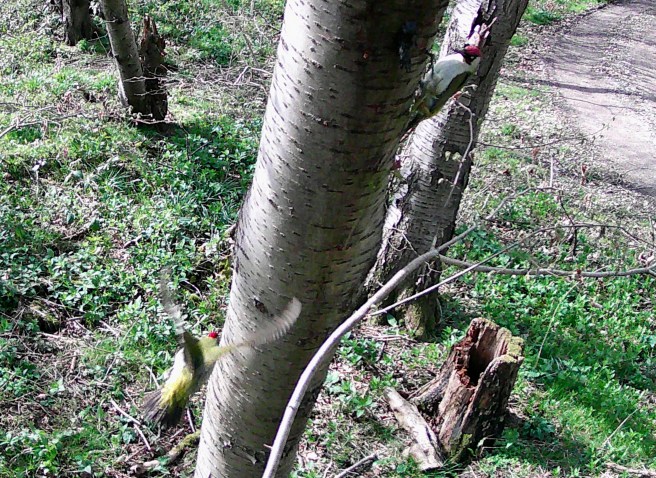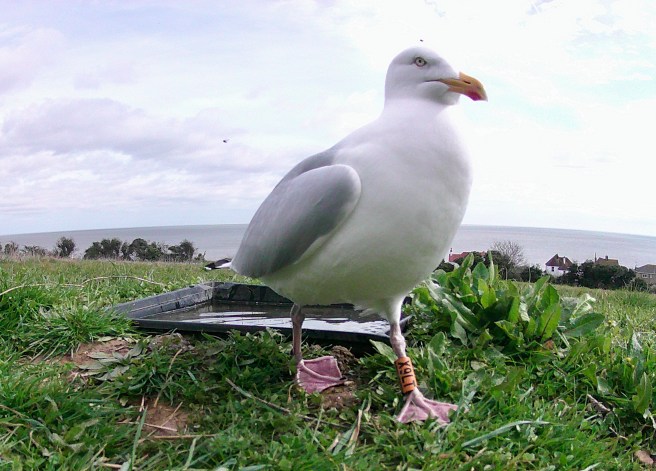There has been some bat excitement this week and it all started with this photograph:

There are four bats around the tree, including the one perched at the entrance to the hole. The ears suggest that these are Brown Long-eared Bats, which tend to live in light woodland and typically roost in trees. They do indeed have the most fantastic ears.

The ecologist helping us with the Dormouse monitoring is also a bat expert and she told us that bat tree roosts are very transitory at this time of year, when they have recently awoken from hibernation and before they have properly settled down. We met her at the wood that same evening just before dark to try to catch them emerging from the hole.
She arrived with a lot of high tech and expensive equipment. These bat detectors were very good, showing the frequency of calls of any passing bat and also saving the data so that it can be reviewed and properly analysed later.

Two infrared floodlights and a sophisticated IR camera were trained on the hole. Even when it got completely dark, that camera had a remarkable view as if it were still daytime:

We then waited for it to get dark. The Pipistrelles are the first bats to emerge at dusk and soon we had a Soprano Pipistrelle feeding along the track behind us. It was light enough to still see it by eye and, for the first time, not only could I watch a bat but I also knew exactly which species it was, which greatly increased my appreciation of it. Before long there were several Soprano and Common Pipistrelles flying around us.

But we were waiting for the Brown Long-eared Bats and they don’t come out until it is properly dark – around 45 minutes after sunset. And then, on cue, there were five Long-eared Bats above our heads – seen by the bat expert but but we beginners could see nothing. The bat detectors, however, recognised their quiet, lower frequency calls. Bats make their echo-locating calls in order to hear the reflected sound back, and Long-eared bats with their enormous ears don’t need the sound to be very loud to still be able to hear it.
But we hadn’t seen these amazing bats emerging from the hole in the tree that we were monitoring and, in fact, subsequent review of the camera footage showed that they did not come out of there. The manner in which they were flying, though, apparently suggested that they had just emerged very close by – perhaps even from another of the several holes in that same tree.
I wonder if the bats had looked in the woodpecker hole and decided not to go in because there was a woodpecker in there? The birds are definitely still interested in the tree:

It was really enjoyable evening although a shame, of course, that we didn’t get photos of the bats emerging. There are now plans to try to spend another evening in the wood with bat detectors once the monitoring season is properly underway from May.
In the meantime, we are now inspired to install our three new Kent bat boxes in the wood. With open bottoms, these wooden boxes with recycled plastic coverings are self cleaning and, once up, can be left alone for many years.

Elsewhere in the wood, we have a camera looking at a fox den. It seems that I was wrong last week when I said that one of the foxes using the den was heavily pregnant – even though she is definitely stout, I now see that she is lactating:

And her tiny cubs have already been born:



The camera on the owl box has captured some more visits of a Tawny Owl to the box but not as many as might be expected if a bird was sitting on eggs in there. I have had a thought – perhaps the nest itself is located elsewhere and this box is being used as an occasional roost for the bird that is not busy incubating the eggs?


Other interesting photos from the wood this week:





Over in the meadows, the baby badgers have once again been moved, and in the same direction as the last two times. My latest theory is that, underground, these mischievous little cubs are crawling away from their nursery and the mother is having to repeatedly return them, doing so overground where there is more space to carry them. Here is the first cub:

Nine minutes later, a second one is carried across:

Foxes and badgers live in close proximity here and yet they largely manage to completely avoid each other. On a recent wild night, however, the roar of the wind meant they couldn’t hear much else as both a badger and a fox tried to use the hole under the fence at the same time. The badger initially jumped back in surprise:

The fox was also shocked and its knee jerk reaction was to hiss:

But then the badger, having taken stock and remembered she was the top dog, charged at the fox who strategically withdrew backwards:


What fun. I love to observe the interactions between these two species as they are forced to rub along together.
An altogether more peaceful badger scene:

The One-eyed Vixen has once more caught mange and I have just finished giving her, and our other foxes here, a course of medicine delivered in nightly honey sandwiches which they love:

Now we wait with our fingers crossed to see if the hair loss continues or if the treatment has worked and her fur starts to regrow.
On this same camera this week, there was a Tawny Owl on the ground. It is unusual to see a Tawny Owl in the meadows:

I suppose owls do need to go down onto the ground to catch their rodent prey but I can’t help but worry for them after we got this photo in November 2021 of a fox carrying an owl:

Other photos from the meadows this week:








In our daughter and her fiancé’s garden in the North Downs, the hedgehogs have awakened:

I wonder if they will get hoglets this year? I do hope they do.
I finish today with a photo of our dog with one of the cowslips which, like little yellow chandeliers, are lighting up the meadows this April.

